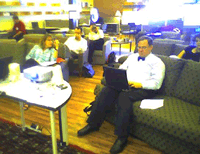I received this comment the other day on a recent weblog called Our Schools are Leaking. Rather than burying another comment in there, I thought I would just comment here in a separate article, because what this writer says is quite important.
Interesting thoughts. There is no question that kids are connected these days. I teach high school in a small rural Kansas town. All of our students have lap tops and the whole school is wirelessly enabled. I’m intrigued by this idea that all of this access means that our students want to learn with technology….
I’m going to break in here and rant just a bit. This is not aimed directly at the commentor, but at all of us. We have been so focused on “technology” that we have a sense of two worlds: a classroom that integrates technology and one that doesn’t. Now this limiting mentality isn’t a part of our planning and deep discussions about modern teaching and learning. However, when we use phrases like “integrate technology“, it implies that the focus should be on the tool, and less on the curriculum, content, or outcomes.
Alan November describes this well, when he distinguishes between automating and informating education. The difference to me is that automating is simply swapping out the old tools for the new, without really changing the process, while informating focuses more on the information. To put my twist on it, informating means reflecting on the changing nature of information, and then adapting what and how we teach and learn to the new information environment.
Let’s get back to the comment.
I teach high school math. Most of my efforts to integrate technology into real learning activities has been trial and error. When I asked my classes today what they had done on their computers in the last year that really helped them learn – none of them could come up with a single thing. Was interesting. I thought we had done several things that would help them – they don’t see it that way. It was an eye opening discussion for me. Kids are connected more than ever, and they like it. They want to be connected. Trick is, using for learning, not just recreation.
I want to respond to this idea. I do not know the author of the comment or the classes he is describing. But the idea intrigues me. I have to say that I am not surprised that the students could not itemize what they have learned using technology. In fact, in my humble opinion, if they could itemize their learning, then we probably aren’t integrating the technology to its fullest potential.
It’s like vacation. When you were young and went to the beach or mountains on vacation, could you have listed things that you learned while playing in the sand dunes or along the mountain trails. Yet, in your adulthood, you know that you learned a great deal during these activities of exploration. Now I’m not saying that technology use in the classroom should be a vacation. It should, however, be play. The key is getting students to play the information. If you prefer, you can say “Work the information,” but it’s all the same. When kids are interacting with the information, then they will learn.
The idea that all kids will learn better outside the container is as silly as the idea that all kids used to learn well inside the container.
True enough. Again, it isn’t either/or. I’m saying that we need to punch some holes in our containers so that the tentacles of our students growing attention stream (their computers, mobile phones, IM, etc.) can freely extend out into the world that we are teaching them about, within the context/container of curriculum. But grant them enough freedom to learn by playing the information environment.
If you are teaching history, then visit an online museum, and IM or even speakerphone one of the curators with questions. In math, find someone in your community who uses math skills that you are teaching, and IM or speakerphone them periodically. Go out on the Net and find authentic data for your students to calculate, and then have them write up conclusions and publish them in print or online. It’s about the information, not the technology. It’s about taking advantage of the networked and digital nature of information.

 I received an e-mail yesterday from an educator in Charlotte, NC, where I spoke to district principals this summer (the stockcar theme was great fun). I thought that I would pose my response as a blog entry and invite others to chime in.
I received an e-mail yesterday from an educator in Charlotte, NC, where I spoke to district principals this summer (the stockcar theme was great fun). I thought that I would pose my response as a blog entry and invite others to chime in. It seems that almost every day there is something in the news about the declining numbers of science, engineering, and technology graduates in the United States. I shared stories a while back about (
It seems that almost every day there is something in the news about the declining numbers of science, engineering, and technology graduates in the United States. I shared stories a while back about ( I spent two days, last week, sitting with a group of educators in a renovated tobacco warehouse in Durham, North Carolina. The residence of Duke CE, a corporate education firm, the now upscaled facility became a short-term incubator of ideas — about teaching and learning.
I spent two days, last week, sitting with a group of educators in a renovated tobacco warehouse in Durham, North Carolina. The residence of Duke CE, a corporate education firm, the now upscaled facility became a short-term incubator of ideas — about teaching and learning.